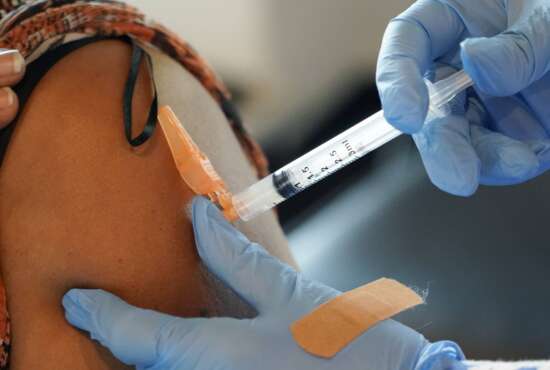
Increase in military suicide rates continues troubling trend
In today's Federal Newscast, the Defense Department is seeing troubling new figures in military suicide rates.
To listen to the Federal Newscast on your phone or mobile device, subscribe in PodcastOne or Apple Podcasts. The best listening experience on desktop can be found using Chrome, Firefox or Safari.
- The Defense Department is seeing troubling new figures in military suicide rates. The Pentagon saw a 15% increase in military suicides in 2020 compared to the year before. Last year, 580 troops took their own lives. The Army is having an especially hard time with the issue. It’s seen suicides increase every year for the past five years. Army Secretary Christine Wormuth said in response that it is the service’s goal to get soldiers the help they need and to make it readily accessible. Some experts have pointed to isolation during the pandemic as a factor for an increase in the general suicide rate.
- Congress achieved perhaps one of the easiest items on yesterday’s to-do list: Avoiding a government shutdown. The House and Senate both passed a nine-week continuing resolution that will keep agencies running through Dec. 9. The Senate cleared the CR with bipartisan support. And President Joe Biden signed it into law with a few hours to spare before the midnight deadline. The CR includes over $28 billion in disaster relief funding and almost $7 billion for Afghan resettlement efforts. Congress still must find a way to raise or suspend the debt ceiling before mid-October. (Federal News Network)
- The House has passed legislation to create a new job series in software and data. Under the bill, the Office of Personnel Management has 270 days from enactment to create one or more occupational series covering federal positions in software development, software engineering, data science and data management. The legislation was initially introduced in May by Rep. Jay Obernolte (R-Calif.) and overwhelmingly passed by a 416-to-9 vote.
- An updated software framework is available to agencies and other organizations as they look to comply with mandates in President Joe Biden’s cybersecurity executive order. The National Institute of Standards and Technology released Version 1.1 of the Secure Software Development Framework this week. The guidance links to different clauses in the executive order laying out how agencies and contractors should securely develop software. NIST is also looking for feedback to incorporate in its next update of the framework.
- Post offices are taking a hit from natural disasters. Natural disasters in recent years damaged more than 1,000 Postal Service facilities and cost the agency more than $30 million to repair. Hurricane Maria caused the biggest toll, leading to nearly $15 million in damage at 43 sites. The Government Accountability Office said more than a third of USPS facilities are in areas at risk of a natural disaster. Flooding, wildfires, storm surges and rising seas levels are just a few of the threats USPS properties face.
- Federal contractors lawyers are still scratching their heads about the vaccine mandate. Federal contractors are to show proof of vaccination by Dec. 8, but guidance from the Safer Federal Workforce Taskforce on implementation has been broad, leaving contractor lawyers to question how to advise their clients as the guidance evolves. Contractors are waiting for the Federal Acquisition Regulatory Council to put out a regulatory clause to provide further clarity on how to move forward. The vaccine mandate follows more complicated compliance challenges that the contracting community has seen in the last few years, including the ban on Chinese telecommunications equipment.
- The Department of Homeland Security is ramping up communication efforts with employees about the vaccine. DHS officials said 64% of the department’s workforce is vaccinated. Deputy Undersecretary for Management Randolph “Tex” Alles. “We want to encourage them. We certainly don’t want to lose employees over vaccinations. That’s our starting point as we work this down. Really communicating with them and making available vaccines is a critical part of this effort.” All federal employees have until Nov. 22 to be fully vaccinated under the Biden administration’s mandate. (Federal News Network)
- The Air Force is getting close to fulfilling its mandate that all active-duty airmen get vaccinated against COVID-19. Ninety-four percent of airmen have received at least one shot and 75% are fully vaccinated. The Defense Department said in August that it would require all service members to get the shot. The Air Force then set the standard that all active duty airmen be fully vaccinated by Nov. 2. Reserve and Air Guard have until December.
- Just over a year into the e-marketplace platform proof of concept, the General Services Administration still has not fully identified its metrics of success. A new report from the Government Accountability Office found GSA needs to establish a comprehensive plan that outlines goals and timeframes for each metric. Auditors say this will better position GSA to measure if the program is being implemented successfully or if the program needs changes before it is ultimately expanded governmentwide, as is the current plan. Additionally, GAO says GSA needs to take additional steps to ensure the three portal providers are doing enough to protect federal data.
- The General Services Administration is helping federal buildings save money by putting up solar panels. Its inspector general found the agency’s solar panel pilot saved the federal government $330,000 in energy costs between 2018 and 2020. But the IG said the GSA could do a better job selecting sites for the pilot. It found GSA paid more for electricity at two solar powered-sites than what local utility companies would have charged. The GSA pilot is focused on its Pacific Rim region that covers California, Nevada, Arizona, and Hawaii.
- Four agencies and six projects won the first tranche of money from the Technology Modernization Fund’s $1 billion account. GSA, OPM, Education, DHS and one classified agency crossed the finish line to win more than $311 million from the Technology Modernization Fund. Out of the more than 100 proposals the TMF board received, these seven were chosen as ready for an influx of money to accelerate their modernization efforts. GSA received three awards for a zero trust initiative, to expand Login.gov and to modernize the MAX.gov website. OPM and the Education Department also won awards to help with zero trust implementations. DHS received funding for technology to protect the southwest border. (Federal News Network)
Copyright © 2025 Federal News Network. All rights reserved. This website is not intended for users located within the European Economic Area.
Eric White
Eric White is news anchor and Federal Drive producer at Federal News Network.
Follow @FEDERALNEWSCAST
Related Stories
Unanswered vaccine mandate questions remain for contractors after FAR Council rule
Related Topics
All News
Army
Army
continuing resolution
COVID-19 vaccine
COVID-19 vaccine mandate
Cyber Workforce
Cybersecurity executive order
Defense
Defense News
Department of Homeland Security
e-marketplace
executive order
Federal Acquisition Regulatory Council
Federal Drive
Federal Newscast
General Services Administration
Management
mental health
military suicide
National & World Headlines
Pentagon
Postal Service
renewable energy
Safer Federal Workforce Task Force
technology modernization fund
Tom Temin
Workforce
zero trust




